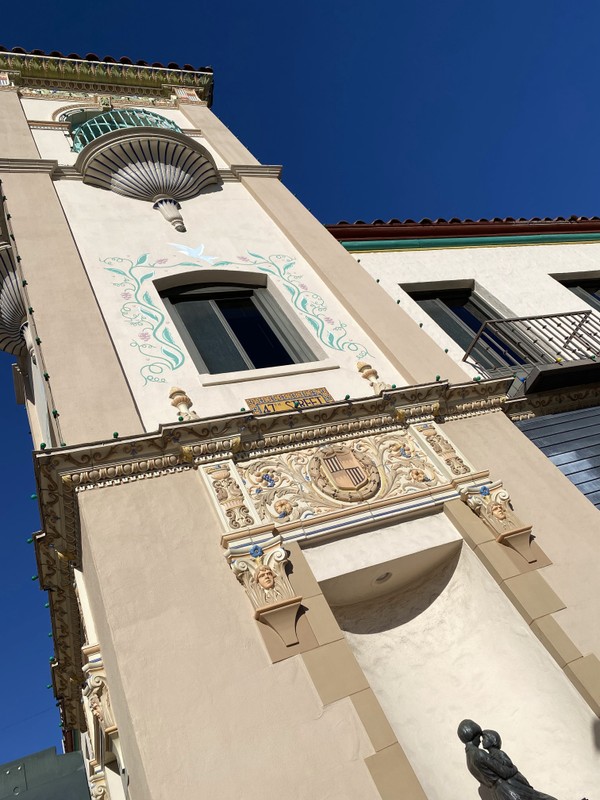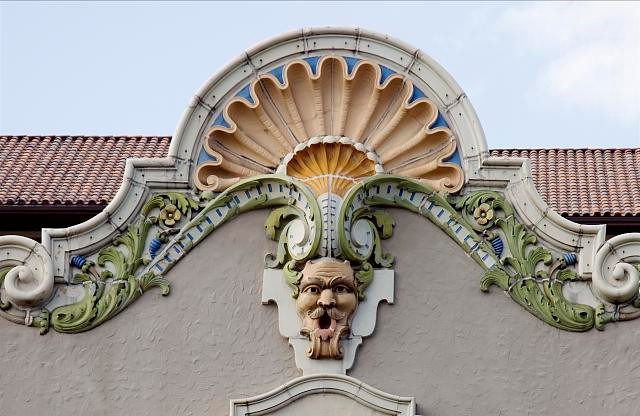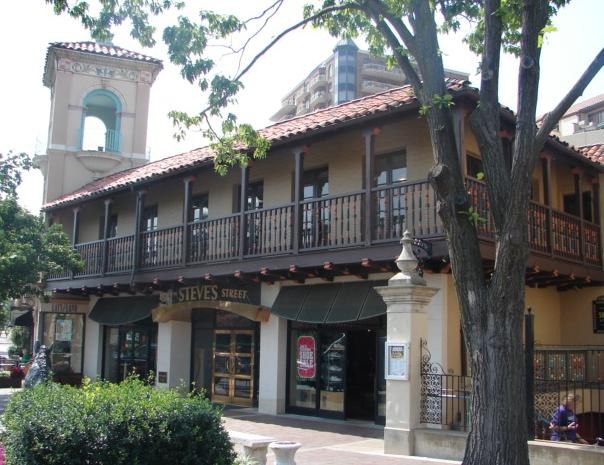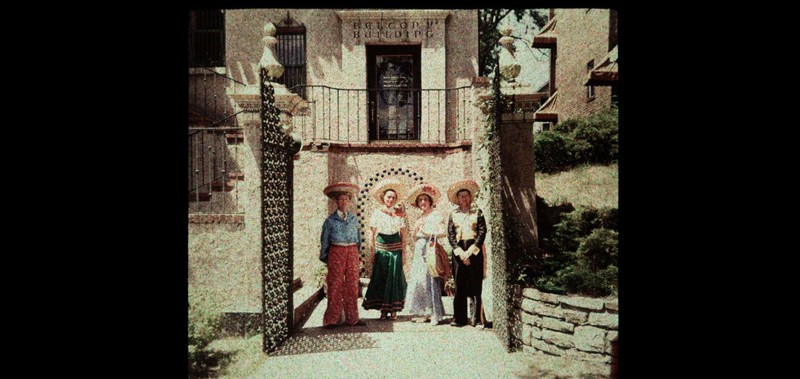Balcony Building
Introduction
Text-to-speech Audio
Architect Edward Tanner employed the Plaza’s unified Spanish Revival design for the Balcony Building which was completed in 1925. As one might expect, the structure features a large balcony along the upper level on the east side, as well as two Spanish style towers, ornate terracotta detail, a clay tile roof, shaped parapets, and a highly decorative central gable with a large, carved face that makes this building distinguishable. Throughout the years, the building has served as retail and restaurant space at ground level while the upper level primarily contained business and doctors' offices. A few of its earlier tenants include Steve’s Shoes, Huff Secretarial School, and an emergency room that was operated by two physicians. In 2010, the Balcony Building was threatened with demolition for a new office building, but the historic structure was saved due to preservation efforts and city ordinances that were designed to preserve historic structures while maintaining a neighborhood's unique architecture.
Images
The towers of the Balcony Building feature ornate terracotta detail and metalwork.

The curvilinear gable above the central entrance features ornate detail and a large, carved face

From this vantagepoint, both towers of the Balcony Building are visible
.jpg)
The balustrade balcony extends the length of the upper level on the east side. Pictured at the ground level is Steve's Shoes, an anchor store for the Balcony Building from its establishment in 1938 through 2006

A group of patrons attending the Country Club Plaza Fiesta stop for a photo at the east entrance to the Balcony Building, a location that is now the sunken courtyard of Aleman Court. Notice the area of landscaping to the east which has since been built on.

Backstory and Context
Text-to-speech Audio
As part of the first phase of building the Country Club Plaza, the Balcony Building was constructed in 1925. The completion of this structure followed shortly after the Suydam (now Mill Creek Building), Triangle Building, and the Tower Building. Those structures were completed in 1923, and the Wolferman’s Store (now home to Commerce Bank) was completed in 1924. Together with the Balcony Building, these five buildings were part of the Plaza's “bowl-shaped” design plan which placed low-rise buildings toward the center surrounded by taller buildings with towers around the edge. J.C. Nichols envisioned the towers of these buildings to be unified and eventually build up to a large, centralized tower with chimes.
Designed by leading architect Edward Tanner, the Balcony Building, like much of the Plaza, exhibits a Spanish Colonial and Revival style. It features shaped parapets, a stucco exterior, polychrome terracotta ornamentation, a clay tile roof, and iron balconies. A Spanish-style tower is positioned at each of the front corners and a balustrade balcony extends the length of the upper level on the east side of the building. Additionally, the facade above the central entrance extends into a decorative gable containing a distinguished face and impressive detail is positioned at the header of major doorways and windows.
The Balcony Building had a variety of tenants as retail and restaurant businesses filled the street level while business and doctors' offices occupied the upper-level spaces. By the 1940s, the retail environment was changing and the Plaza continued growth. New buildings were added and some businesses moved locations to make way for others to expand. In fact, J.C. Nichols declined dozens of new businesses in order to take care of the expansion of the current tenants. In 1947, the front sidewalk was rebuilt and parking was added to the back. Aleman Court was also established this year, in the new sunken courtyard on the east side. One of the first tenants of the Balcony Building, Wimer’s restaurant was one of the first to expand, adding space from a different shop that moved out. Others include Steve’s Shoes, an anchor from 1938 to 2006, expanded retail space and added a repair shop; a public accountant moved out and the already established office of Dr.’s Shofstall and Webb doubled the size of their space and provided beds as an emergency hospital; additional doctors and offices featuring new, state of the art equipment were added on the second level replacing the Huff Secretarial School; and the Putsch’s opened their third restaurant on the Plaza, Putsch’s Cafeteria. Occupants continued to change over the years but the Balcony Building still remains an essential component of the Plaza.
In 2010, the Balcony Building was threatened with demolition when local law firm and former tennant Polsinelli proposed the construction of a new office building at this location. However, J.C. Nichols had worked with city leaders to put restrictions in place regarding renovation and construction. In addition, the city's 1989 Urban Design and Development Plan included measures to preserve the historical look of the Plaza in addition to placing limits on the size of buildings. The law firm's extensivie plans envisioned development beyond the scope of these plans. While construction within the Plaza proved untenable for the developers, the firm was able to acquire a location a few blocks away and completed a ten-story modern building in 2013.
Architect Edward W. Tanner (1896-1974) was a longtime partner to J. C. Nichols. After receiving a degree from the school of Engineering and Architecture at the University of Kansas, Tanner enlisted as an artillery instructor during World War I. When he returned to Kansas City Tanner was hired as the principal designer for the Nichols Company but left a few years later to open his own firm. During World War II, Tanner was contracted by the government to design regional hospitals and airfields. After the war he resumed business in Kansas City, also receiving commissions from Nichols while the two continued to build the city’s picturesque landscape. Designing many of the prominent buildings on the Plaza, the district came to be known nationally as “the Nichols towers with that Tanner wham.” Tanner also designed more than 2000 homes in the area, including those of Tom Pendergast and Walter E. Bixby - one of his most modern designs and on the National Register of Historic Places.
Sources
Betz, Melanie A.. North Plaza Survey, Missouri State Parks. Accessed January 22nd 2022. https://mostateparks.com/sites/mostateparks/files/KC%20N%20Plaza%20Report.pdf.
Moore, Greta. Community organizes to preserve the Plaza’s legacy, UMKC Roo News. September 14th 2010. Accessed January 22nd 2022. https://info.umkc.edu/unews/community-organizes-to-preserve-the-plazas-legacy/.
Country Club Plaza Walking Guide, Historic Kansas City. Accessed January 22nd 2022. https://www.historickansascity.org/wp-content/uploads/2018/04/98973-Historic-KC-LR_nocrops.pdf.
Missouri SP Bixby, Walter E., House, National Archives Catalog. Accessed January 22nd 2022. https://catalog.archives.gov/id/63819234.
Progress of The Plaza in 1946-1947, State Historical Society of Missouri. Accessed January 22nd 2022. https://files.shsmo.org/manuscripts/kansas-city/nichols/JCN080.pdf.
Personal photo, 2022
https://www.loc.gov/pictures/resource/highsm.04143/
Personal photo, 2022
http://www.oshealtd.com/meetoshea.htm
https://kchistory.org/image/four-people-entrance-country-club-balcony-building?solr_nav%5Bid%5D=2b5a16edec436dee940c&solr_nav%5Bpage%5D=0&solr_nav%5Boffset%5D=7
